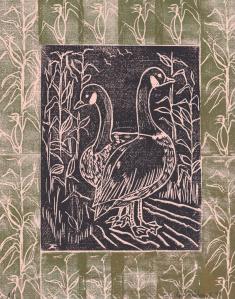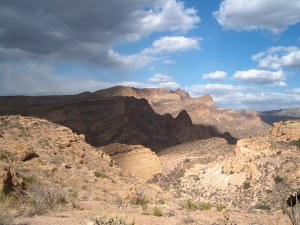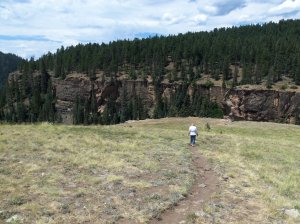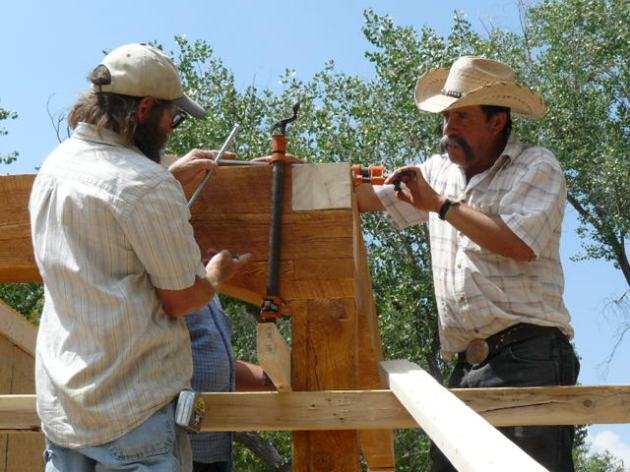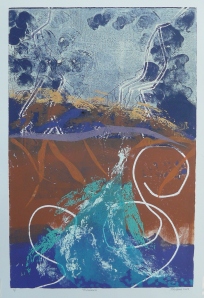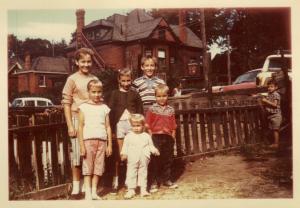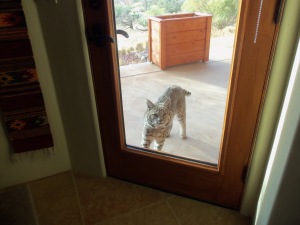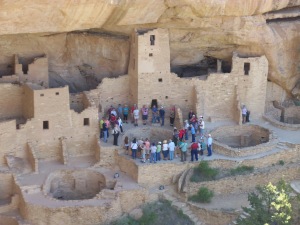
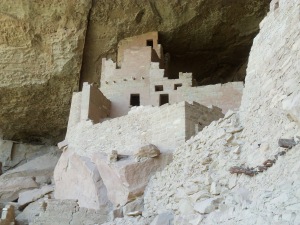
We can’t say we haven’t been warned. The ranger, a woman who would be considered elderly anywhere else wears her uniform with authority. She lists the reasons we should consider carefully before descending the trail to the Cliff Palace in Mesa Verde National Park, giving us a chance to change our minds. We are gathered around her in a group of about 40 under the intense sun of southwest Colorado, some of us regretting we did not wear a hat (me). We are all tourists whether we came from a few hours away or an ocean and continent away. I hear languages I can’t identify and regional accents of the United States.
As defined by the Merriam-Webster dictionary, a tourist is “one that makes a tour for pleasure/culture”. I would add we tour because of our insatiable curiosity to see the different, to stand in the actual presence of our history and to leave, if only for a little while, the routine, the ordinary, the crowded and close, the safe and predictable. I would guess that we are also present in this place for the open blue skies and the incomprehensible space of this part of the country and the mysteries hidden in its canyons.
Americans have been ridiculed for decades as boorish, loud-mouthed tourists, unaware of cultural differences, tasteless and disrespectful in our attire and intrusive with our questions. I have seen the images of large Americans in baggy shorts photographing the pigeons on the Piazza San Marco but now that everyone dresses like an American it is hard to tell who is from where unless it is their language. As I look around me everyone is dressed in shorts and T-shirts and sensible shoes except for the man from Arkansas wearing overalls. He looks flushed and asks if there is a railing. In this tourist group we are all polite and friendly, offering to take photos of each other. The Americans are their usual unvarnished and open selves. I find companionable comfort in being with them.
I mentally check the list of reasons the ranger gives that might prevent me or others from descending: bad joints, iffy hearts, decreased lung capacity, not enough water (me), fear of heights (my husband), symptoms of altitude sickness. The latter condition seems evident when I see people meandering through the parking lot between moving cars as if they are in a daze. With a little leeway in qualifications, I think I am ready to go but my anxiety increases when the ranger says that once you are down there is only one way out which involves ladders. It increases a bit more when she tells us there was a fatality last year. The group grows quiet except for the very young.
We start to file down a narrow rock stairway to the path. On a steep turn, I grab a juniper branch jutting out. It is worn as smooth as marble by the thousands of hands which have also reached for this anchor. I am feeling a bit smug. After all, I live at 7500 feet above sea level, bike regularly and have scrambled over many treacherous paths. I should be able to handle this better than the flatlanders. I also don’t want to be left out or left behind. I want to keep up, to forestall the day when I can’t keep up with others and with life in general.
I think that if you are of the boomer generation it is expected that you will keep fit, eat healthy foods because you finally know better, be mentally active or at least seem so and be comfortable with technology. This does not include multiple TV remotes (me). You are not expected to be irrelevant or sedentary in your 60’s and 70’s. It has been an intense course of catch-up for me in the past five years – learning how to use a PC, navigating around all the social media and information options, building a “web presence”, marketing online, trying to get back into shape. None of these things were required of my maternal forebears nor would they be seen climbing onto a bike or into and out of a canyon as I am about to do. Sometimes I just want to give up and live like an old person, with no expectations from anyone.
We walk along a path overlooking a steep drop and ascend the first ladder to the next path. With a smile and an “I’m ok” I pass on taking the hand of a young woman who reaches back to help me up. My denial of being an older woman knows no bounds unless there is a mirror in front of me. The ranger directs us to gather under an overhanging ledge of sandstone and sit if possible. She tells us that personal space is not an option and in this case we don’t mind, even the big Americans used to lots of personal space. There is something reassuring in a gathering of strangers crowded on a narrow ledge, backs and knees touching. It is a trust that no one will carelessly knock you over the edge while we huddle together in the shade.
The Cliff Palace looms silent and impressive with its galleries of stone rooms, juniper beams, kiva pits and granaries. I am most fascinated by the small windows on the second and third stories of the pueblo and imagine people looking out of them, watching for their families returning from planted fields on the mesa above, watching their children playing, watching for visitors – friend or enemy. They watched as I watch now this motley crew that is us, tourists in an utterly quiet place that once sheltered about 300 people. We learn that no burial ground has been discovered, only a few human remains in the trash pits under the common area. They were a practical people it seems.
When the time comes to leave it is by the only way out, three ten-foot ladders anchored in narrow stone passages, almost a vertical ascent to the top. I am nervous and breathing a bit hard but so delighted by my circumstances that I climb, smiling all the way, hand over hand, foot over foot. It is hard but even harder for the sheriff from Florida with bad knees. He is in rough shape. On the way up I place my right hand in the small hand and footholds carved into the rock by the cliff dwellers, smoothed from hundreds of years of use. These people climbed up and down the rock walls daily to work their fields and bring back food. I thought about how impossible it would be for an old person to climb like that, using only niches in the rock. When the practical cliff dwellers abandoned their homes in the fourteenth century, they must have had to leave behind some of the old ones who were too frail to make the exodus.
Perhaps if I had lived then I would have recognized the burden I would have placed on my people and accepted the inevitable. I would sit on the stone walls, listen to the wind and the ravens, remember the voices I loved and wait. But right now, in this time and place, I climb the strong juniper ladders, not wanting to be left behind.
If you would like to know more about the early people of the southwest and the author’s incredible journey to find their traces, I would recommend Craig Childs’ “House of Rain”.www.houseofrain.com
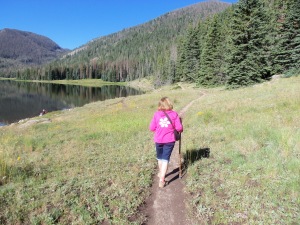 ride my bike more and explore the back roads of Arizona and the other western states. I want to be more present in nature even if it’s just the field outside my door. So I am going to take a hiatus from WordPress for awhile. I may chime in again someday, probably later than sooner.
ride my bike more and explore the back roads of Arizona and the other western states. I want to be more present in nature even if it’s just the field outside my door. So I am going to take a hiatus from WordPress for awhile. I may chime in again someday, probably later than sooner.
